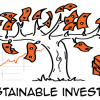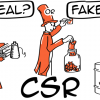Script
4 root causes of unsustainability
What are the root causes of unsustainability? Can we boil it down to only four basic things that we do as a human society that are unsustainable? Well let’s get drawing
In the first video we discussed how a group of 50 scientists managed to get a consensus on natural cycles and we concluded that sustainability is actually the capacity of our human society to continue indefinitely within the natural cycles. So if you haven’t watched the first video make sure you do that before watching this one. And from there, the group of scientists looked at the things that we do in our human society that interfere with natural cycles in order to identify the root causes of unsustainability. So they came up with four. There’s no priority order. They’re all equally important. They’re all necessary and sufficient.
The first one is that we extract large lows of materials from the earth’s crust (the lithosphere). These materials are things like oil, like natural gas, heavy metals that are rare in the biosphere and that we extract in such large quantities that they accumulate and nature cannot cope
The second one is that we create in our society substances that accumulate in nature. We create chemical compounds that nature takes a very long time to break
down but we also create substances that already exist in nature, like carbon dioxide for example, but in such a very large quantities that they accumulate and nature cannot cope.
The third one is that we physically inhibit nature’s ability to run the natural cycles. How do we do that? Well for example by chopping trees at a faster rate than they can grow, by systematically destroying ecosystems and replacing them with parking lots, roads, buildings, etc. so that nature cannot run its cycles anymore.
These are 3 ecological root causes. Once again there’s no priority order. The fourth one is social and can actually be the most important of all. We create in our society barriers to people meeting their basic human needs worldwide. So we will unpack
in another video this notion of basic human needs. It is very interesting and they are things like creativity, identity, participation and so on and so forth. So how do we do that? Well for example if you purchase a product that is manufactured in a sweatshop in the developing country, indirectly you support the business and indirectly you contribute to poor working conditions in this factory and to the fact that these people are unable to meet their basic human needs.
So this is the scientific consensus on the 4 root causes of unsustainability.
As usual, here is are the key points to keep in mind:
- Scientists agree that there are only four root causes of unsustainability based on natural cycles;
- 3 are ecological and 1 is social: they are necessary, sufficient and non-overlapping;
- If we stop doing these four things we will be sustainable.







Nice Video – Thanks for your efforts.
However, I believe you are confusing Symptoms with Causes. The underlying cause of the first three and part of the 4th is over population, over consumption and inequity usually driven by selfish greed or generations of traditions.
I define an Ecologically Sustainable Population as a population which is living in balance with the biosphere. The level of population does not degrade the environment, resources available for future generation are not depleted and wastes from all resource use are not returned to the ecosystem faster than they can be safely absorbed and reconstituted by natural systems. Each generation leaves the earth in a better condition that what they inherited. A perfect balance between the degradation of the environment and the restoration of the environment is not practical over the short or long term. To ensure there is a net positive benefit, with a high margin of safety we must all strive to pollute less than we restore and consume less than nature can replace. One way to ensure we all live in “credit” is to be actively involved in the restoration of the damage previously done by past generations. For all forms of degradation, we should strive to be “Carbon Negative”, or equivalent, over our lifetime. Only then can we begin the lifelong journey of restoration of the rich diversity of the biosphere, so necessary for life. When the health of the entire ecosystems continues to improve year after year, as extinctions stabilise, wild fish stocks rebound, temperatures stabilise and fall, glaciers stabilise and then grow, as the deep rain forests expand and consumption continues to decline, we will know we are headed in the right direction. But when the biosphere begins to heal and re-wild itself, without our helping hand, only then will we know we have truly met the definition of an ecologically sustainable population.
Population is a sensitive subject but must be addressed. In spite of overwhelming evidence that we have exceeded global limits from all quarters, such as Earth Overshoot Day and the four planetary boundaries, that have been exceeded (W. Steffen et al., 2015) , so many of us deny that endless economic growth and population growth are at the core of the problem. We deny reality for many understandable reasons, and the readers are asked to self-assess which reasons may apply to them. They include:
• It challenges our powerful beliefs that underpin our cherished lifelong philosophy and ideology. Our beliefs about economic growth and our rights to have as many children as we want.
• Narratives which are often accepted without analysis. Messages, such as, “Growth is Good” are promulgated daily by news reports, commentary, political interviews, the advertising machine of consumerism, our respected professional peers and all these messages, reinforce our denial of alternative evidence. For example, “Sydney outgrew Melbourne in the last quarter” or “The new housing market surged to a record high” or “The treasurer announced a spectacular jump in GDP”, etc. Many messages are subliminal. But together, all these messages make challenging the growth mantra hard to do and taking the denial pathway, a much easier choice.
• Humanity has a strong tendency to deny problems (optimism bias), particularly if the consequences are far in the future. They are often denied because they force us to ‘confront change’ which can be disruptive and particularly challenging as many do not realise there are good alternate pathways and solutions.
There are many more reasons, but time is short.
When an Ecologically Sustainable Population and consumption, along with intergenerational equity, have been achieved, then a Steady State Economy becomes a reality. This will give humanity a chance. Some believe a long-term sustainable population is less than 2 billion.
Keep up the good work.
I hope I have given you anther perspective. To fix the problems one must address the causes, not the symptoms.
Regards, Graham
Thank you for your in depth comment!
excellent video!!!
Good video, I look forward to watch more videos on your website, excellent, thanks
Good video, I look forward to watch more videos on your website, excellent, thank you